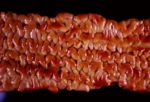Johne's Disease
| This article is still under construction. |
| Also known as: | Paratuberculosis |
Description
Johne's Disease is a contagious and chronic disease of ruminants caused by the bacteria Mycobacterium avium subsp. paratuberculosis (MAP). Affected species include cattle, sheep, goats and camelids. The disease is responsbile for severe economic losses due to reduced reproductive performance, increased susceptibility, reduced milk production and losses due to culling of affected animals.
Pathogenesis
MAP is primarily spread through herds via faecal-oral transmission, contaminated water and in utero. Young animals less than a year of age are most susceptible to infection and usually become infected through ingestion of contaminated milk or colostrum. Environmental factors such as overcrowding and dirty pens may increase the risk of infection. Following ingestion of M. paratuberculosis, infection begins in the ileum. Following uptake by the Peyer's Patches, M. paratuberculosis infects macrophages in the gastrointestinal tract and lymph nodes leading to a granulomatous inflammatory response.
Clinical Signs
There is a long incubation period between infection and the development of clinical signs ranging from a year to several years. Animals may be affected subclinically before overt clinical signs are displayed. In the early stages, the disease is characterised by reduced milk production, reduced reproductive performance and increased susceptibility to infection or disease.
In the later phases of infection, the clinical signs become more severe. The characteristic clinical signs are of watery 'pipe-stem' diarrhoea and severe wasting (despite maintaining a good appetite). The disease is progressive and advanced cases may develop submandibular or ventral oedema due to a protein losing enteropathy.
The disease is similar in goats and sheep except diarrhoea is not a feature.
Gross Pathology
Lesions are usually localised to the terminal portion of the ileum. The mucosal surface is diffusely thickened with transverse, corrugated rugae which do not disappear when the intestinal wall is stretched. In sheep and goats however, nodule formation with necrosis and calcification may be seen.
Infected animals may also have enlarged mesenteric lymph nodes.
There are many large macrophages (epithelioid macrophages) in mucosa, submucosa and lymph nodes.
The mesenteric lymph nodes are pale and enlarged (though not necrotic), and the lamina propria is infiltrated by sheets of macrophages with some lymphocytes. Acid-fast bacteria are found in the macrophages and giant cells, and this is detected by Ziehl-Neelson stain.
Diagnosis
Diagnosis is difficult, particularly in the case of subclinical disease as there is no single test that will detect all stages of the disease. The most commonly used diagnostic test is the ELISA which detects antibodies to M. paratuberculosis in clinically affected animals.
.
60% of cases have lesions in colon and rectum and can be diagnosed by rectal biopsy.
I
